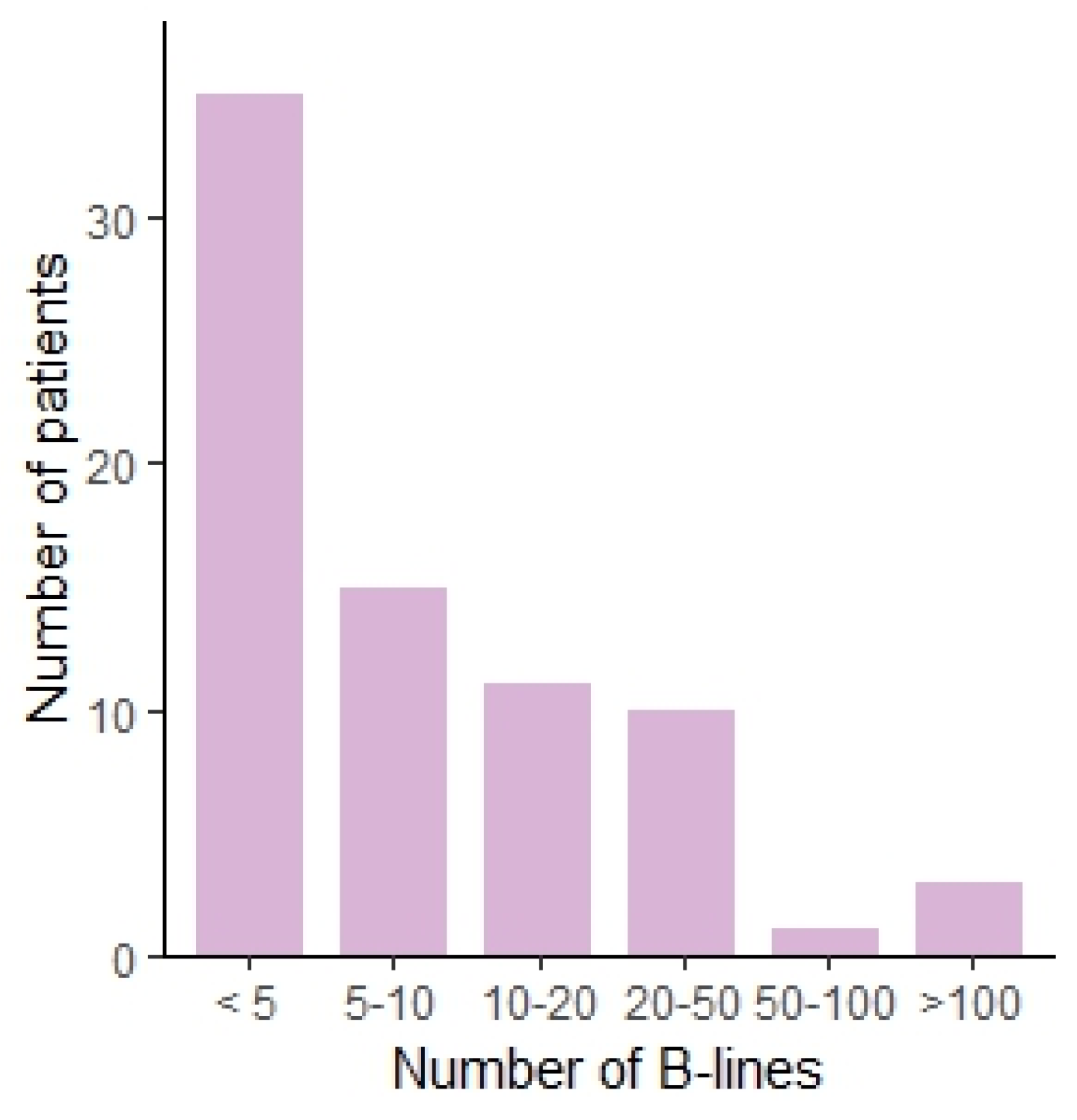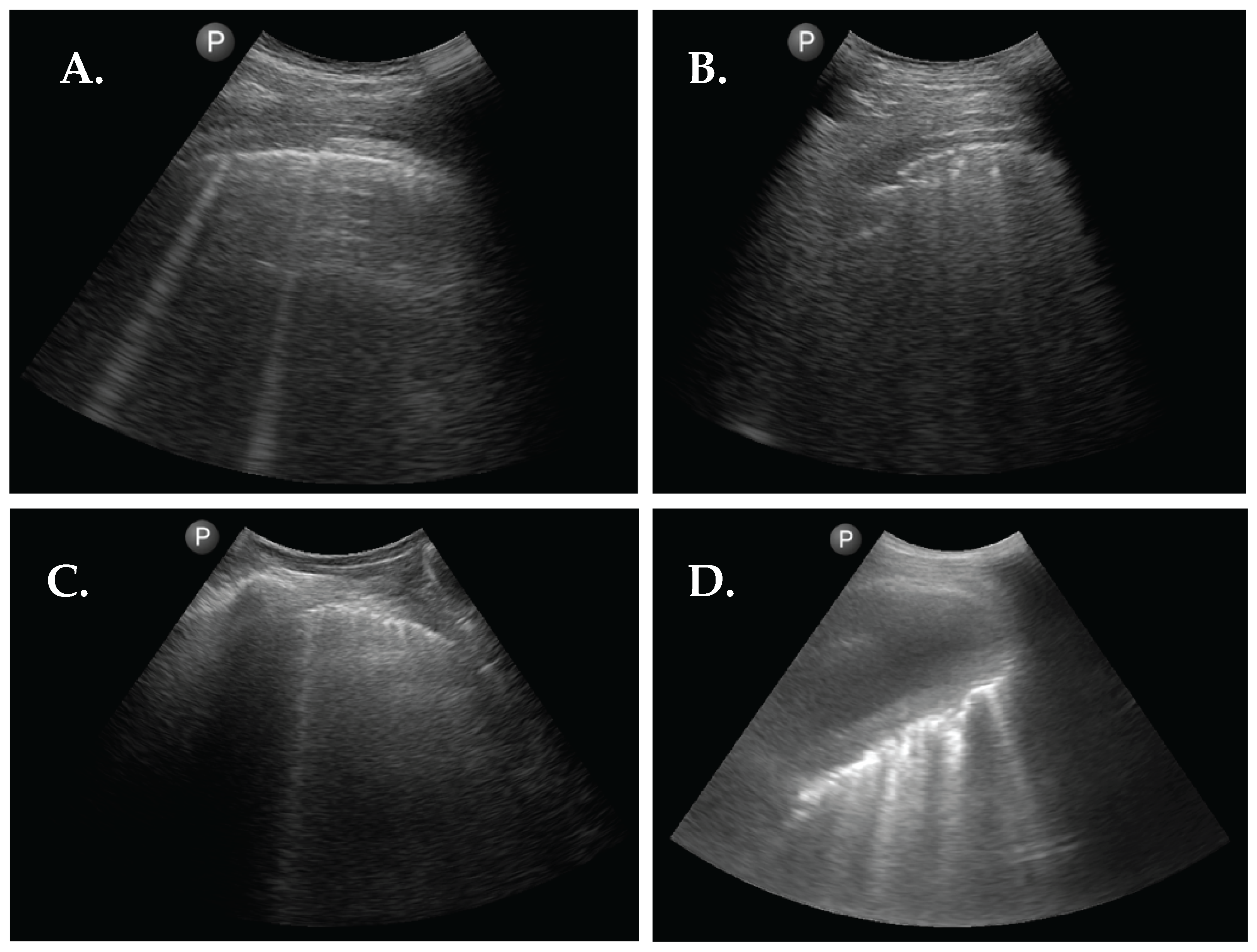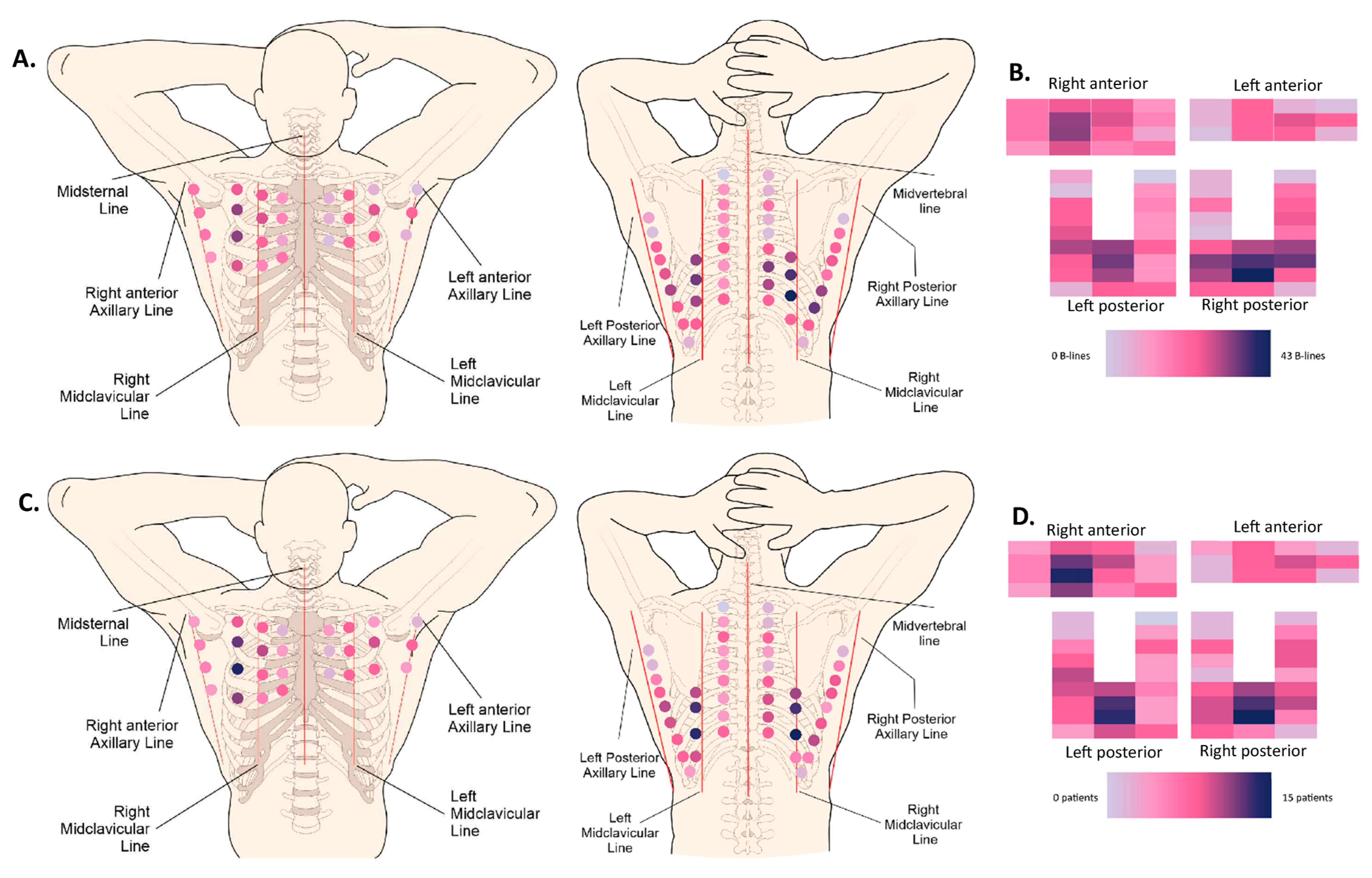Ultrasonographic Presentation and Anatomic Distribution of Lung Involvement in Patients with Rheumatoid Arthritis
Abstract
1. Introduction
2. Methods
2.1. Lung Ultrasound
2.2. Statistical Analysis
2.3. Creation of Figures
3. Results
3.1. Baseline Characteristics and Statistical Analysis
3.2. LUS Patterns



4. Discussion
5. Conclusions
Author Contributions
Funding
Institutional Review Board Statement
Informed Consent Statement
Data Availability Statement
Acknowledgments
Conflicts of Interest
References
- Kadura, S.; Raghu, G. Rheumatoid arthritis-interstitial lung disease: Manifestations and current concepts in pathogenesis and management. Eur. Respir. Rev. 2021, 30, 210011. [Google Scholar] [CrossRef] [PubMed]
- Lee, H.K.; Kim, D.S.; Yoo, B.; Seo, J.B.; Rho, J.Y.; Colby, T.V.; Kitaichi, M. Histopathologic pattern and clinical features of rheumatoid arthritis-associated interstitial lung disease. Chest 2005, 127, 2019–2027. [Google Scholar] [CrossRef] [PubMed]
- Solomon, J.J.; Chung, J.H.; Cosgrove, G.P.; Demoruelle, M.K.; Fernandez-Perez, E.R.; Fischer, A.; Frankel, S.K.; Hobbs, S.B.; Huie, T.J.; Ketzer, J.; et al. Predictors of mortality in rheumatoid arthritis-associated interstitial lung disease. Eur. Respir. J. 2016, 47, 588–596. [Google Scholar] [CrossRef] [PubMed]
- Spagnolo, P.; Lee, J.S.; Sverzellati, N.; Rossi, G.; Cottin, V. The Lung in Rheumatoid Arthritis: Focus on Interstitial Lung Disease. Arthritis Rheumatol. 2018, 70, 1544–1554. [Google Scholar] [CrossRef] [PubMed]
- Spagnolo, P.; Cordier, J.-F.; Cottin, V. Connective tissue diseases, multimorbidity and the ageing lung. Eur. Respir. J. 2016, 47, 1535–1558. [Google Scholar] [CrossRef] [PubMed]
- Jacob, J.; Hirani, N.; van Moorsel, C.H.M.; Rajagopalan, S.; Murchison, J.T.; van Es, H.W.; Bartholmai, B.J.; van Beek, F.T.; Struik, M.H.L.; Stewart, G.A.; et al. Predicting outcomes in rheumatoid arthritis related interstitial lung disease. Eur. Respir. J. 2019, 53, 1800869. [Google Scholar] [CrossRef] [PubMed]
- Olson, A.L.; Swigris, J.J.; Sprunger, D.B.; Fischer, A.; Fernandez-Perez, E.R.; Solomon, J.; Brown, K.K. Rheumatoid arthritis-interstitial lung disease-associated mortality. Am. J. Respir. Crit. Care Med. 2011, 183, 372–378. [Google Scholar] [CrossRef]
- Johnson, T.M.; Yang, Y.; Roul, P.; Sauer, B.C.; Cannon, G.W.; Kunkel, G.; Michaud, K.; Baker, J.F.; Mikuls, T.R.; England, B.R. A Narrowing Mortality Gap: Temporal Trends of Cause-Specific Mortality in a National Matched Cohort Study in US Veterans with Rheumatoid Arthritis. Arthritis Care Res. 2022, 75, 1648–1658. [Google Scholar] [CrossRef]
- Kocakaya, D.; Aksoy, A.; Yalçınkaya, Y.; Inanç, N.; Eryüksel, E.; Karakurt, S. Cavitary nodules in rheumatoid arthritis patients and their prognosis. Eur. Respir. J. 2018, 52 (Suppl. S62), PA4116. [Google Scholar] [CrossRef]
- Perez, T.; Remy-Jardin, M.; Cortet, B. Airways involvement in rheumatoid arthritis: Clinical, functional, and HRCT findings. Am. J. Respir. Crit. Care Med. 1998, 157 Pt 1, 1658–1665. [Google Scholar] [CrossRef] [PubMed]
- Geri, G.; Dadoun, S.; Bui, T.; Del Castillo Pinol, N.; Paternotte, S.; Dougados, M.; Gossec, L. Risk of infections in bronchiectasis during disease-modifying treatment and biologics for rheumatic diseases. BMC Infect. Dis. 2011, 11, 304. [Google Scholar] [CrossRef] [PubMed]
- Hassan, W.U.; Keaney, N.P.; Holland, C.D.; A Kelly, C. Bronchial reactivity and airflow obstruction in rheumatoid arthritis. Ann. Rheum. Dis. 1994, 53, 511–514. [Google Scholar] [CrossRef] [PubMed]
- Fuld, J.P.; Johnson, M.K.; Cotton, M.M.; Carter, R.; Watkin, S.W.; Capell, H.A.; Stevenson, R.D. A longitudinal study of lung function in nonsmoking patients with rheumatoid arthritis. Chest 2003, 124, 1224–1231. [Google Scholar] [CrossRef][Green Version]
- Schneider, H.A.; Yonker, R.A.; Katz, P.; Longley, S.; Panush, R.S. Rheumatoid vasculitis: Experience with 13 patients and review of the literature. Semin. Arthritis Rheum. 1985, 14, 280–286. [Google Scholar] [CrossRef]
- Tourin, O.; de la Torre Carazo, S.; Smith, D.R.; Fischer, A. Pulmonary vasculitis as the first manifestation of rheumatoid arthritis. Respir. Med. Case Rep. 2013, 8, 40–42. [Google Scholar] [CrossRef] [PubMed][Green Version]
- Bartels, C.M.; Bell, C.L.; Shinki, K.; Rosenthal, A.; Bridges, A.J. Changing trends in serious extra-articular manifestations of rheumatoid arthritis among United State veterans over 20 years. Rheumatology 2010, 49, 1670–1675. [Google Scholar] [CrossRef] [PubMed]
- Watts, R.A.; Mooney, J.; Lane, S.E.; Scott, D.G. Rheumatoid vasculitis: Becoming extinct? Rheumatology 2004, 43, 920–923. [Google Scholar] [CrossRef] [PubMed][Green Version]
- Balbir-Gurman, A.; Yigla, M.; Nahir, A.M.; Braun-Moscovici, Y. Rheumatoid Pleural Effusion. Semin. Arthritis Rheum. 2006, 35, 368–378. [Google Scholar] [CrossRef]
- Moazedi-Fuerst, F.C.; Kielhauser, S.M.; Scheidl, S.; Tripolt, N.; Lutfi, A.; Yazdani-Biuki, B.; Dejaco, C.; Graninger, W. Ultrasound screening for interstitial lung disease in rheumatoid arthritis. Clin. Exp. Rheumatol. 2014, 32, 199–203. [Google Scholar]
- Tardella, M.; Di Carlo, M.; Carotti, M.; Filippucci, E.; Grassi, W.; Salaffi, F. Ultrasound B-lines in the evaluation of interstitial lung disease in patients with systemic sclerosis: Cut-off point definition for the presence of significant pulmonary fibrosis. Medicine 2018, 97, e0566. [Google Scholar] [CrossRef]
- Gargani, L.; Bruni, C.; Romei, C.; Frumento, P.; Moreo, A.; Agoston, G.; Guiducci, S.; Bellando-Randone, S.; Lepri, G.; Belloli, L.; et al. Prognostic Value of Lung Ultrasound B-Lines in Systemic Sclerosis. Chest 2020, 158, 1515–1525. [Google Scholar] [CrossRef]
- Fairchild, R.; Chung, M.; Yang, D.; Sharpless, L.; Li, S.; Chung, L. Development and Assessment of Novel Lung Ultrasound Interpretation Criteria for the Detection of Interstitial Lung Disease in Systemic Sclerosis. Arthritis Care Res. 2021, 73, 1338–1342. [Google Scholar] [CrossRef]
- Vicente-Rabaneda, E.F.; Bong, D.A.; Castañeda, S.; Möller, I. Use of ultrasound to diagnose and monitor interstitial lung disease in rheumatic diseases. Clin. Rheumatol. 2021, 40, 3547–3564. [Google Scholar] [CrossRef]
- Bruni, C.; Mattolini, L.; Tofani, L.; Gargani, L.; Landini, N.; Roma, N.; Lepri, G.; Orlandi, M.; Guiducci, S.; Bellando-Randone, S.; et al. Lung Ultrasound B-Lines in the Evaluation of the Extent of Interstitial Lung Disease in Systemic Sclerosis. Diagnostics 2022, 12, 1696. [Google Scholar] [CrossRef] [PubMed]
- Volpicelli, G.; Elbarbary, M.; Blaivas, M.; Lichtenstein, D.A.; Mathis, G.; Kirkpatrick, A.W.; Melniker, L.; Gargani, L.; Noble, V.E.; Via, G.; et al. International evidence-based recommendations for point-of-care lung ultrasound. Intensive Care Med. 2012, 38, 577–591. [Google Scholar] [CrossRef] [PubMed]
- Barskova, T.; Gargani, L.; Guiducci, S.; Randone, S.B.; Bruni, C.; Carnesecchi, G.; Cerinic, M.M. Lung ultrasound for the screening of interstitial lung disease in very early systemic sclerosis. Ann. Rheum. Dis. 2013, 72, 390–395. [Google Scholar] [CrossRef]
- Eibenberger, K.L.; Dock, W.I.; Ammann, M.E.; Dorffner, R.; Hörmann, M.F.; Grabenwöger, F. Quantification of pleural effusions: Sonography versus radiography. Radiology 1994, 191, 681–684. [Google Scholar] [CrossRef] [PubMed]
- Sperandeo, M.; Filabozzi, P.; Varriale, A.; Carnevale, V.; Piattelli, M.; Sperandeo, G.; Brunetti, E.; Decuzzi, M. Role of thoracic ultrasound in the assessment of pleural and pulmonary diseases. J. Ultrasound 2008, 11, 39–46. [Google Scholar] [CrossRef]
- Aletaha, D.; Neogi, T.; Silman, A.J.; Funovits, J.; Felson, D.T.; Bingham, C.O., III; Hawker, G. 2010 Rheumatoid arthritis classification criteria: An American College of Rheumatology/European League Against Rheumatism collaborative initiative. Arthritis Rheum. 2010, 62, 2569–2581. [Google Scholar] [CrossRef]
- Gargani, L.; Doveri, M.; D’Errico, L.; Frassi, F.; Bazzichi, M.L.; Delle Sedie, A.; Scali, M.C.; Monti, S.; Mondillo, S.; Bombardieri, S.; et al. Ultrasound lung comets in systemic sclerosis: A chest sonography hallmark of pulmonary interstitial fibrosis. Rheumatology 2009, 48, 1382–1387. [Google Scholar] [CrossRef]
- Hassan, R.I.; Lubertino, L.I.; Barth, M.A.; Quaglia, M.F.; Montoya, S.F.; Kerzberg, E.; Binda, M.d.C. Lung Ultrasound as a Screening Method for Interstitial Lung Disease in Patients with Systemic Sclerosis. Am. J. Clin. Oncol. 2019, 25, 304–307. [Google Scholar] [CrossRef] [PubMed]
- Gargani, L.; Volpicelli, G. How I do it: Lung ultrasound. Cardiovasc. Ultrasound 2014, 12, 25. [Google Scholar] [CrossRef]
- Fischer, E.A.; Minami, T.; Ma, I.W.Y.; Yasukawa, K. Lung Ultrasound for Pleural Line Abnormalities, Confluent B-Lines, and Consolidation. J. Ultrasound Med. 2021, 41, 2097–2107. [Google Scholar] [CrossRef]
- Wang, Y.; Gargani, L.; Barskova, T.; Furst, D.E.; Cerinic, M.M. Usefulness of lung ultrasound B-lines in connective tissue disease-associated interstitial lung disease: A literature review. Arthritis Res. Ther. 2017, 19, 206. [Google Scholar] [CrossRef]
- Mena-Vázquez, N.; Jimenez-Núñez, F.G.; Godoy-Navarrete, F.J.; Manrique-Arija, S.; Aguilar-Hurtado, M.C.; Romero-Barco, C.M.; Ureña-Garnica, I.; Espildora, F.; Padin-Martín, M.I.; Fernández-Nebro, A. Utility of pulmonary ultrasound to identify interstitial lung disease in patients with rheumatoid arthritis. Clin. Rheumatol. 2021, 40, 2377–2385. [Google Scholar] [CrossRef]
- Kumar, A.; Weng, Y.; Graglia, S.; Chung, S.; Duanmu, Y.; Lalani, F.; Gandhi, K.; Lobo, V.; Jensen, T.; Nahn, J.; et al. Interobserver Agreement of Lung Ultrasound Findings of COVID-19. J. Ultrasound Med. 2021, 40, 2369–2376. [Google Scholar] [CrossRef] [PubMed]
- Gutierrez, M.; Salaffi, F.; Carotti, M.; Tardella, M.; Pineda, C.; Bertolazzi, C.; Bichisecchi, E.; Filippucci, E.; Grassi, W. Utility of a simplified ultrasound assessment to assess interstitial pulmonary fibrosis in connective tissue disorders-preliminary results. Arthritis Res. Ther. 2011, 13, R134. [Google Scholar] [CrossRef] [PubMed]
- Verma, A.; Kumar, I.; Siddiqui, Z.; Chokhani, A.; Srivastava, G.N.; Shukla, R.C. Performance of semi-quantitative lung ultrasound in the assessment of disease severity in interstitial lung disease. Ann. Thorac. Med. 2021, 16, 110–117. [Google Scholar] [CrossRef] [PubMed]
| n (%) | |
|---|---|
| Female | 47 (62.67%) |
| Seropositive | 62 (82.67%) |
| RF-positive | 45 (60%) |
| ACPA-positive | 57 (76%) |
| Ever-smoker | 47 (62.67%) |
| Active smoker | 9 (12%) |
| Current treatment | |
| csDMARD | 24 (32%) |
| csDMARD + bDMARD | 30 (40%) |
| bDMARD | 8 (11%) |
| csDMARD + tsDMARD | 4 (5%) |
| CS + csDMARD | 8 (11%) |
| CS | 1 (1.33%) |
| Median—IQR | |
| Age at inclusion | 64.17 (16.79) |
| Age at RA diagnosis | 46.75 (22.12) |
| RA duration | 12.35 (14.40) |
| DAS-CRP | 2,2 (1.25) |
| VAS pain | 40 (50) |
| VAS fatigue | 35 (60) |
| Pack years if smoker | 15 (22) |
| n (%) | |
|---|---|
| B-lines | |
| <5 | 35 (46.7%) |
| 5–10 | 15 (20%) |
| 10–20 | 11 (14.6%) |
| 20–50 | 10 (13.3%) |
| 50–100 | 1 (1.3%) |
| >100 | 3 (4%) |
| Pleural abnormalities | 34 (45.3%) |
| Subpleural nodules | 11 (14.7%) |
| Pleural effusion | 1 (1.3%) |
Disclaimer/Publisher’s Note: The statements, opinions and data contained in all publications are solely those of the individual author(s) and contributor(s) and not of MDPI and/or the editor(s). MDPI and/or the editor(s) disclaim responsibility for any injury to people or property resulting from any ideas, methods, instructions or products referred to in the content. |
© 2023 by the authors. Licensee MDPI, Basel, Switzerland. This article is an open access article distributed under the terms and conditions of the Creative Commons Attribution (CC BY) license (https://creativecommons.org/licenses/by/4.0/).
Share and Cite
Vermant, M.; Kalkanis, A.; Goos, T.; Cypers, H.; De Crem, N.; Neerinckx, B.; Taelman, V.; Verschueren, P.; Wuyts, W.A. Ultrasonographic Presentation and Anatomic Distribution of Lung Involvement in Patients with Rheumatoid Arthritis. Diagnostics 2023, 13, 2986. https://doi.org/10.3390/diagnostics13182986
Vermant M, Kalkanis A, Goos T, Cypers H, De Crem N, Neerinckx B, Taelman V, Verschueren P, Wuyts WA. Ultrasonographic Presentation and Anatomic Distribution of Lung Involvement in Patients with Rheumatoid Arthritis. Diagnostics. 2023; 13(18):2986. https://doi.org/10.3390/diagnostics13182986
Chicago/Turabian StyleVermant, Marie, Alexandros Kalkanis, Tinne Goos, Heleen Cypers, Nico De Crem, Barbara Neerinckx, Veerle Taelman, Patrick Verschueren, and Wim A. Wuyts. 2023. "Ultrasonographic Presentation and Anatomic Distribution of Lung Involvement in Patients with Rheumatoid Arthritis" Diagnostics 13, no. 18: 2986. https://doi.org/10.3390/diagnostics13182986
APA StyleVermant, M., Kalkanis, A., Goos, T., Cypers, H., De Crem, N., Neerinckx, B., Taelman, V., Verschueren, P., & Wuyts, W. A. (2023). Ultrasonographic Presentation and Anatomic Distribution of Lung Involvement in Patients with Rheumatoid Arthritis. Diagnostics, 13(18), 2986. https://doi.org/10.3390/diagnostics13182986






